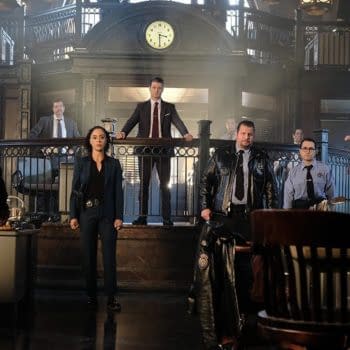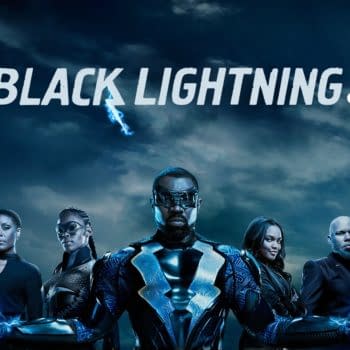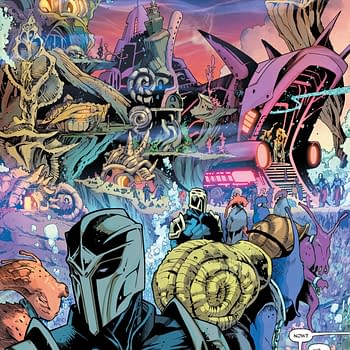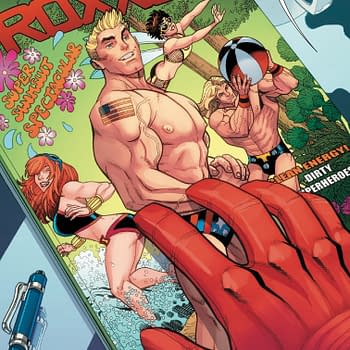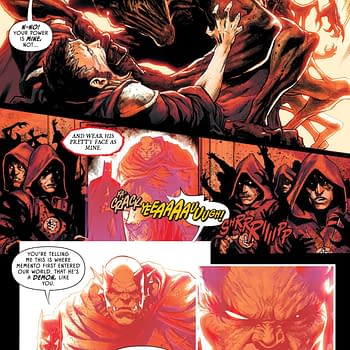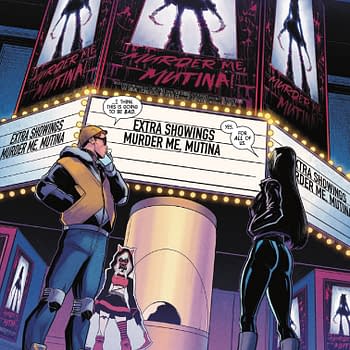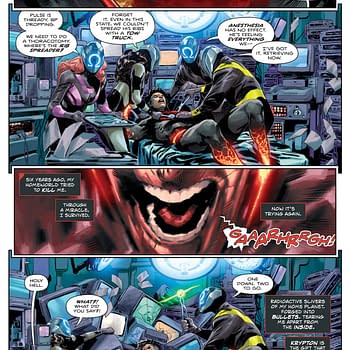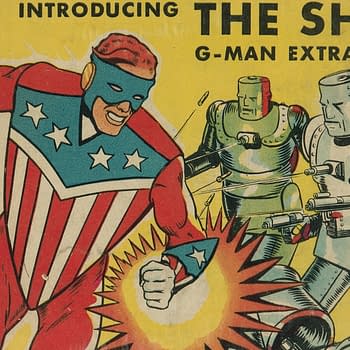Posted in: Comics | Tagged: barbarella, Comics, dynamite, entertainment, HRL, joe jusko, mike carey
Writer's Commentary: Mike Carey on the Important Messages in Barbarella #1
Dynamite has sent us a new writer's commentary for their brand new Barbarella series. Mike Carey goes page by page through the first issue. Here we also see covers by Kenneth Rocafort, Joe Jusko, and Joseph Michael Linsner with interior art by Kenan Yarar.
Page 1:
We had a lot of ground to cover in this first issue in terms of world-building – giving the sense of a society that's both familiar and alien, getting Barbarella into prison and out of it again, introducing her and the supporting cast and laying the groundwork for the wider conflict. So it seemed to make sense to hit the ground running, with a space battle in progress and Barbarella flung into the middle of it.
Some of the first sketches I saw from Kenan [Yarar, artist] were of the crew of the Parosian flagship as we see them in this scene – and I knew at once that he was a great fit for the book. He embraced the weirdness of this alien theocracy and brought his own craziness to the party. The stained glass window is a particularly nice touch.
Page 2:
If you want to sing We Labour in the Vineyards of the Seven, like a good son or daughter of the church, it fits in a rough and ready way to the tune of Oh, What a Friend We Have in Jesus.
It was my editor Matt's [Idelson] suggestion that we make the Parosians polytheists, so as to minimise the sense that we were getting at any specific religion. Any of our readers who are believers are more likely to believe in a single god than a whole pantheon (all due apologies to the comic fans who are Hindus, Buddhists or Shintoists).
In the original outline I had the Parosians worshipping a mother goddess, but matriarchal religions are usually much more laid back when it comes to matters of sex. The Parosians are fairly uptight, and their sexual hang-ups are very much a plot point.
Pages 3-4:
I thought long and hard about how to bring Barbarella on stage for the first time. Jean-Marc L'Officier, who is a creative consultant on the book, said at one point that he saw the original Barbarella stories as a kind of adult Alice in Wonderland. Like Alice, Barbarella wanders into outrageous situations and takes them in her stride. She accepts the insane logic of the universe she lives in, but she never allows it to compromise her own sense of how things should be. I really like that definition of the character.
So here Barbarella finds herself in the middle of a war, but she's not intimidated by the Parosian military. She knows her rights. She also knows her ships, and she's already reading a lot into this military encounter. We get to hear some of the clues she picked up here, and more later when she meets Jury Quire.
Incidentally, I didn't originally have any sound effects for the scene in which Barbarella's ship is snared. I added them when I saw how beautifully and playfully Kenan had interpreted that scene.
Re: Barbarella's outfit: she lives in outer space, mostly on ship-board, so as in the original series she wears a serviceable space suit that covers most of her body – not a spandex bikini or a costume with strategically placed holes in it. She gets naked when she feels like it: the rest of the time she dresses for serious sh*t because it's generally not far away.
Apart from the boots, of course. She wears high-heeled boots with fold-down tops because her fashion sense was forged in the '60s.
Page 5:
We weren't being coy in avoiding the word "vagina" here. Barbarella uses it herself a little later in the story. I just wanted to generate a little curiosity about what Barbarella is supposed to be smuggling.
We did try to make sure the scan as un-erotic as possible, though – by blurring the line between Barbarella's naked body and her sub-dermal muscle and tissue. At the back of my mind here were the millimeter-wave scanners now in common use at airports, which produce a photographically real image of a passenger's entire body. I know there are measures in place to make that less intrusive – including blurring faces and introducing a "double blind" system where the scanner's operator doesn't see the passenger. It still freaks me out a little that there is now a working version of the X-ray specs that used to be advertised in the back of DC comics in the 70s. What happens to Barbarella here is possible with technology we have today.
Page 6:
Alert readers will see some odd details in this cityscape. They're meant to be there, and they're indications that there is more for Barbarella to discover about Parosian society. That's for issue 2, though. For now I just wanted to give Kenan enough space to draw a panorama. He didn't disappoint me. He did point out that if I let him have a double-page spread he could have done even more. Soon, Mr. Yarar, soon.
The billboards look like a homage to Futurama, but I was actually remembering those wayside pulpits with their terrible clever-clever messages that are meant to make you think but generally just make you wince. There was one in my neighbourhood that (for many months) read: SOUL-AR POWERED BY THE SON OF GOD.
"She has demonic powers to tempt men's souls." Woman as the devil's gateway into the human soul is a fun feature of many orthodox religions. The Parosians didn't invent it. In orthodox Christianity, Eve was the one who listened to the serpent and was responsible for original sin, something that medieval clerics never got tired of bitching about. You eat one lousy apple and your entire gender has its cards marked for the rest of time.
Page 7:
I'm not sure where I got the idea of a rifle that fires sermons. I needed to insert some exposition, and I wanted to do it in a way that didn't seem forced. After all, the defendant in a criminal trial has a right to know what she's being accused of: the judge in this case chooses the most direct means.
I use a lot of different words to describe the ranks of the Parosian religious hierarchy. Deacons, prebends and lictors are all present. We also meet a number of people like the ship's captain in the opening scene and the judge here, whose military and civil roles seem to overlap with a religious one. The state religion is the axle tree on which the whole of Parosian society turns – like the Communist party in Stalinist Russia, say; or in the UK, talking about the weather.
Page 8:
"My body is my own concern!" Of course it is. But that has never stopped religious authorities from trying to control what you do with it. Or civil authorities either, to be fair. If this position can still be read as controversial in the 21st century, I don't hold out much hope that the sort of idiocy embodied in the judge's reply will go out of fashion by Barbarella's time.
I like trial scenes. I seem to have written a ton of them in recent years. I would not, though, want to contest a speeding ticket in a Parosian court.
Page 9:
And now we come to the body loom. It's not entirely clear what sort of physical reconfiguration Barbarella undergoes. The conceptual rifle in the earlier scene talks about "the organs that embody and channel desire." At the very least, this would seem to imply a clitoridectomy.
There's a real-world analogue for this, of course, in the female genital mutilation practised by both Christian and Muslim groups in Africa and Asia. I don't want to get heavy, but this is not a historical curiosity. It's a hugely serious issue NOW. If you want to learn more about it, there's a WHO fact sheet here.
Barbarella gets to meet this technician again in #3. When she says she'll be back, as with Arnold Schwarzenegger, you can take her at her word.
Pages 10-11:
"Whatever you were bringing in, I'd like a taste." I make no apology whatsoever for this smutty joke.
Quire is a character we'll see again later on in the series. I wanted a foil for Barbarella who is as strong-willed and resourceful as her but follows a different agenda. Quire's role as an agent of Earth calls for a lot of moral compromises, and throws Barbarella's sense of right and wrong into sharp relief. By the way, although we don't see it Quire's prison greys reveal that she's in jail for heresy.
There are other differences between them, too. When Rho prays, Quire dismisses her as being wholly enslaved to her Parosian beliefs. Barbarella is less willing to write someone off on such scant evidence, as her later rebuke of Quire shows. Overall, Quire is an ally – and will shortly become more than that – but she may not always be a reliable friend.
Page 12:
I didn't have a whole lot of time to draw in the prison regime, so I just hit the highlights. Unremitting hard labour, terrible food and endless hectoring from the prison officers. And the officers are all robots, which just makes the whole thing that bit more alienating.
Someone smart said something quotable about judging a society by the way it treats its enemies. I think we should be judged by the way we treat our prison population.
Pages 13-15:
Sex as political subversion was a big part of the original story idea. I love the idea of Mills & Boon-style romance novels being illegal contraband – and it's a theme we return to later.
But the true revolutionary act is the orgy, initiated by Barbarella when she kisses and embraces Quire. The salient fact here is not that these are women making love with other women, although the Parosian church would presumably not approve of that. What's crucial, in my mind, is that they're prisoners giving each other pleasure in defiance of the state's attempt to confiscate that pleasure via invasive surgery.
I had to re-read George Orwell's 1984 recently for a panel I was on at Norcon in Oslo. There's a scene in that book where Winston Smith describes Julia as "a revolutionary from the waist down". She doesn't reply "don't knock it until you've tried it", but mainly that's because she lets her actions speak for her. And later in the same book there's a speech where O'Brien talks to Winston about the Party's quest to "abolish the orgasm". Sex is subversive because it's yours, not theirs. They hate that. [Fill in a "they" of your own choice here.]
Page 16:
We don't know whether Quire's body modifications were elective or not. The original script had her wearing a more conventional prosthetic. In my imagination Quire had birth defects affecting one arm and one leg, and turned those physical disabilities into assets in her chosen work. That's absolutely compatible with what Kenan has done here, but his surreal scrolling flesh makes for a much more powerful visual – and makes it more plausible that the Parosians' search regime missed the incredible amount of gadgetry Quire smuggled into jail with her.
We also see here how much Barbarella can pick up from minimal cues. It's easy to forget this in the general whirl of events, but she's crazy smart and she doesn't miss a thing.
We want the nudity in the book to feel natural and casual, not titillating. It used to gripe me sometimes when I was writing superhero books and the artist would sneak in a butt shot or a ridiculously cheese-cakey pose. After sex, you sprawl around companionably, or if it's cold you get back under the covers and huddle, and that's what's going on here. Jean-Claude Forest, in the original books, similarly included a lot of after-sex moments, and I had those in mind when I wrote this sequence.
Pages 17-18:
Barbarella thinking outside the box again, and also laying down the rules for the jailbreak. Of course, she regards robots as fully sentient. She has had more than one robot as a lover (in the original books), so she knows what she's talking about.
Pages 19-22:
The prison break was fun to write. Again, the contrast between the two women is very much to the fore. Quire sticks to the letter of Barbarella's "no killing" rule, by not firing directly at the lictors and vaporising them. But bringing a wall down on their heads is a fairly liberal interpretation of non-lethal damage.
It would have been cool to see the gorgeous baroque structure of the cathedral in all its glory as Barbarella whangs the top off one of its spires, but visibility was low over Parosia's capital city that day. "Was that your first act of blasphemy?" I'm guessing not, but Barbarella's moral compass is a strictly personal thing. She doesn't define herself against anyone else's codes. Hence: "I don't keep count."
At one stage Kenan wanted the razor-doves to look like modern military drones, but in the end we went with a design that was more in keeping with the Parosians' weird tech as seen elsewhere in the issue.
I love the coloring on that final panel, and the way the NEXT teaser sits in one of the pieces of falling debris.
Okay, now I'd better think of a way to get them out of this…















